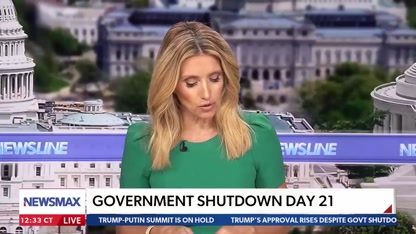
spectator.org
Trump Reloads an ‘America First’ Energy Agenda While Reasserting Sound Science
For a good laugh, turn to page 42 of the report President Donald Trump’s Energy Department released in July. On this page, the huge gulf between climate modeling and observed warming comes into sharp focus. The report includes a chart of all thirty-six climate models as well as the warming that actually occurred from 1973 to 2022 in the U.S. Corn Belt. The big red bars represent what the models predicted for the twelve Midwestern states that make up the Corn Belt, while the tiny blue bar represents the observed amount of warming. Look for yourself.
Subscribe to The American Spectator to receive our fall 2025 print magazine.
We are not talking about some narrow disparity that could be explained away through subsequent studies and minor recalibrations. A chasm has emerged between what global warming alarmists have been telling us for years and what rigorous scientific study actually demonstrates.
The Corn Belt comparison is a particularly acute example of the flawed modeling exercises that have been in motion for years. It’s also one that the Trump administration has brought to light thanks to its willingness to provide five independent scientists with a platform to probe the climate impact of greenhouse gas emissions. The scientists draw from expertise in physical science, economics, climate science, and academic research — and they have upset the climate apple cart by cutting right to the heart of what erroneously has been used to impose expensive regulations on the American economy.
Tear Down These Regulations!
Donald Trump has already had his “tear down this wall” moment, although it may not become apparent for a few decades. That moment came on July 29, 2025, when Trump’s Environmental Protection Agency announced it would begin the process to rescind the “Endangerment Finding” that sits at the heart of the climate agenda. By releasing the Energy Department’s updated scientific report in tandem with the EPA’s reversal of its prior rulemaking, the Trump administration has delivered a powerful one-two punch that will give added momentum to its “America First” energy agenda. Bonner Cohen, a senior fellow with the National Center for Public Policy Research, is all on board with the Trump administration’s strategy and gives special recognition to Chris Wright, the Energy Department secretary, and Lee Zeldin, the EPA administrator. “The Endangerment Finding served as the keys to the kingdom that would deliver the power the alarmists sought,” Cohen said in an interview.
The overreaching of climate activists has been a critical asset along the way toward unleashing American energy.
When posterity looks back at this moment, it will have good cause to place the climate catastrophe predictions in the same category as some other historical doozies. A few that come to mind include Soviet leader Nikita Khrushchev’s line “We will bury you!”; the belief that the Titanic was “unsinkable”; as well as the 1970s “peak oil” predictions that said the world would run out of energy.
Subscribe to The American Spectator to receive our latest print magazine.
But there’s a critical difference when it comes to climate activists. Being sincere, full of conviction, and wrong at the same time is all part of the human condition. But cooking the books to achieve policy goals is another matter. The Climategate scandal of November 2009 exposed Big Science for all to see when emails leaked from the Climate Research Unit at the University of East Anglia in Great Britain, revealing that researchers were willing to fabricate data and muzzle dissenting voices when Mother Nature did not cooperate with theories linking human activity to dangerous levels of global warming.
Since then, climate modeling has only taken on more water, as it has become clear that the faulty assumptions underlying the models continuously run counter to reality. The recent warming that began in the mid- to late twentieth century is much more gradual and modest, and is very likely even beneficial, according to the Energy Department report.
The authors refrain from completely lampooning the example of the Corn Belt modeling failures. Instead, they play it straight, as well they should.
A chasm has emerged between what global warming alarmists have been telling us for years and what rigorous scientific study actually demonstrates.
Readers are told, “This example shows that users need to assess model projections carefully on a case-by-case basis since local biases might be sufficiently large that the models are simply not fit for purpose.” They go on to conclude, “[C]limate models show warming biases in many aspects of their reproduction of the past few decades.”
Those of us who identify as climate skeptics opposed to the overgrowth of the administrative state — which has become a major conduit for unconstitutional policy measures, many of them in the name of climate change — might want to grab a few cigars.
We could gather around the table at a local favorite (I’ll pick Shelly’s Back Room in D.C. for anyone paying attention) — and put our own cheeky spin on what a well-credentialed group of scientists and researchers have produced for the benefit of the American people.
Here’s just a snippet of what might come out of that conversation. It’s put more in laymen’s terms, and with a little less D.C. beltway restraint:
The example of the modeling in the Corn Belt shows us that we are dealing with science fiction. “Users” should know that these models are not designed to reflect reality but are instead designed to advance a political agenda detached from science. We can go on to conclude that the ending is written before the modeling process even begins so that climate activists can line their pockets with taxpayer-funded grants and collaborate with their government benefactors to impose burdensome regulations on those same taxpayers.
That’s the kind of language that’s going to resonate with beleaguered taxpayers and ratepayers who are victimized by climate policies and the junk science that gives rise to those policies. But notice that this imagined rant is not quite so humorous as it reaches the end. Trump’s EPA estimates that climate regulations have cost the American people more than $1 trillion since 2009. That was the year President Barack Obama’s administration issued the “Endangerment Finding” — enabling the EPA to run wild under the Clean Air Act.
How did we get to this point?
In 2007, the U.S. Supreme Court in Massachusetts v. EPA ruled that greenhouse gases qualify as pollutants under the Clean Air Act. Under the act, the EPA must regulate pollutants that it determines can “reasonably be anticipated to endanger public health or welfare.” The Supreme Court left it to Obama’s EPA to determine whether it wanted to expand its authority by controlling carbon dioxide emissions. Not a good idea. Progressive government figures rarely relinquish political power once they have it. This is precisely what the Obama administration did when it finalized the Endangerment Finding in 2009, therefore enabling the EPA to set limits on carbon dioxide emissions from power plants, cars, and trucks, while also imposing methane fees on oil and gas companies. The Endangerment Finding enabled the Obama and Biden administrations to bypass Congress all in the name of fighting what they called the “climate emergency.”
But wait. Should carbon dioxide really be categorized as a pollutant given how beneficial it is for animal and plant life? Here’s the answer we get from our five scientists:
While the definition of “pollutant” is ultimately a legal matter, there are important scientific distinctions between CO2 and the Criteria Air Contaminants. The latter are subject to regulatory control because they cause local problems depending on concentrations that include nuisances (odor, visibility), damage to plants, and, at high enough exposure levels, toxicological effects in humans. In contrast, CO2 is odorless, does not affect visibility and has no toxicological effects at ambient levels. It is a naturally occurring part of the atmosphere and a key component of human and plant respiration. CO2 is essential for plant photosynthesis and higher levels are beneficial for vegetation. In these aspects, CO2 is similar to water vapor.
In other words, carbon dioxide is not a pollutant. Back in our cigar bar, it would not be unreasonable for someone to chime in and describe the assault on carbon dioxide as “an assault on humanity itself.” After all, bigger families with more children and expanding populations breathe out more carbon dioxide. But is this bad news for the planet? Is carbon dioxide the control knob for climate?
The United Nations’ Intergovernmental Panel on Climate Change, or IPCC, which dates back to 1988, published the series of reports most responsible for linking anthropogenic (human) emissions with potentially dangerous levels of global warming. But the team of scientists working with the Energy Department sees “three areas of substantive criticism” that can be directed toward the IPCC: 1) “inadequate assessment of natural climate variability”; 2) “inappropriate statistical methods”; and the now-famous 3) “substantial discrepancies between models and observations.”
Just to briefly discuss No. 1., there is growing evidence that Total Solar Irradiance — the term used to describe the sunlight or energy that arrives at the Earth — is much more significant than what was previously thought. The Energy Department report strongly suggests that the contribution of solar activity to the late-twentieth-century warming has been greatly underestimated by the IPCC and others. The Heritage Foundation has also released a new report on behalf of another independent scientific team, a group called the Center for Environmental Research and Earth Sciences, that takes a deep dive into solar influences. After identifying “at least 27 different estimates of the changes in [Total Solar Irradiance] since 1850,” the Center for Environmental Research and Earth Sciences team concluded, according to Heritage, that “[s]everal of these estimates suggest that global warming is ‘mostly natural,’ and several suggest that global warming is a mixture of natural and human-caused factors.”
There is a healthy debate raging on the causes of climate change that is finally out in the open. If anything, the evidence has shifted in a direction that says we are dealing mostly, but perhaps not entirely, with natural variability.
Cohen, the think tank energy policy analyst, told The American Spectator on the current state of climate science:
For years we were told that “The science is settled on climate change” and that the only responsible thing to do was to clean up our act and go about the urgent business of reordering our society to meet the crisis at hand. The “science is settled” claim was a rhetorical tool designed to shut off any and all debate on the matter. Pretending that models were science was part of the game. Models can be easily manipulated to produce the desired result, and a sufficiently terrified public could be counted on to go along with what their betters said needed to be done to confront the “crisis.” The whole exercise had nothing to do with the climate; rather, the climate served as a pretext for a breathtaking power grab. The Endangerment Finding served as the keys to the kingdom that would deliver the power the alarmists sought.
Looking ahead, there could very well be challenges associated with climate change regardless of the main causes. But humanity will most certainly be in a better position to address those challenges if societies across the globe are wealthier and more economically robust. That scenario doesn’t play out without having access to affordable and reliable energy sources.
The Real Devil: Climate Change or Climate Change Policies?
The Energy Department report warns us that “models and experience suggest that CO2-induced warming might be less damaging economically than commonly believed, and excessively aggressive mitigation policies could prove more detrimental than beneficial.”
Our cigar smokers would like to paraphrase and cut to the chase. Apparently, “We should be concerned not so much with climate change,” they say, “but with harmful climate change policies.”
That’s the succinct, informal way of explaining what’s at stake. Our crew at Shelly’s is also wondering whether the policy damage has already been done, as the regulatory costs flowing out of the Endangerment Finding amount to about $1 trillion.
But help is on the way.
In the same press release announcing its decision to uproot the Endangerment Finding, the EPA also said that if its reversal is finalized, the American people could expect to save $54 billion in annual costs through the repeal of greenhouse gas standards.
There’s an argument to be made that Trump’s decision to move against the Endangerment Finding makes his entire presidency worthwhile just by itself. But there are others worth noting. Tom Pyle, the president of the American Energy Alliance, was pleased to see the “One Big Beautiful Bill” take down what he calls “market-distorting subsidies” for wind and solar schemes. Pyle also credits Trump for withdrawing from the Paris Climate Agreement.
“The Paris Agreement was a bad deal from the start,” Pyle said in a press release. “It committed the U.S. to unilateral economic disarmament by saddling the economy with unnecessary regulations and would have driven energy costs sky-high for American families.”
Had Trump not been reelected to consecutive terms, we would not be talking now about revoking the Endangerment Finding or withdrawing from the Paris Agreement. The four-year interval enabled the president to get all the right personnel in place and to hit the ground running with the right strategy.
Returning for a moment to the chart on page 42 of the report our man Wright put into circulation, my cigar club stumbles on a seemingly obvious mistake the climate critters made that skilled prevaricators typically avoid. Here’s how the conversation goes down in Shelly’s:
“Since the kids are back in school, that’s a reminder for us about how to cheat without getting caught.” That observation comes from a club member asking not to be named. Intrigued, we all press on for an explanation.
“The old joke, and the old rule,” he says, “is that if you’re going to copy off the smart kid sitting next to you, then be sure to get one or two answers deliberately wrong just for the purpose of appearances. After all, if you both get a hundred on the test, they’re sure going to know who the real deal is between the two of you. But the climate goons didn’t learn that lesson.”
No… they sure didn’t. Instead, they went for it all. They bent, manipulated, and reshaped data into all kinds of contortions to produce outcomes in line with their agenda. That much is obvious. These missteps give Team Trump a clear opening to secure lasting, transformative policy changes in the energy space.
Eliminating the Endangerment Finding remains a heavy lift, and there is complicated legal terrain. But the economics and the science are on our side. Let’s also not forget that the complexion of the U.S. Supreme Court has changed in the right ways since Massachusetts v. EPA.
That calls for more cigars!
Kevin Mooney is a journalist and investigative reporter for the Commonwealth Foundation and the Heritage Foundation.
Subscribe to The American Spectator to receive our fall 2025 print magazine.















